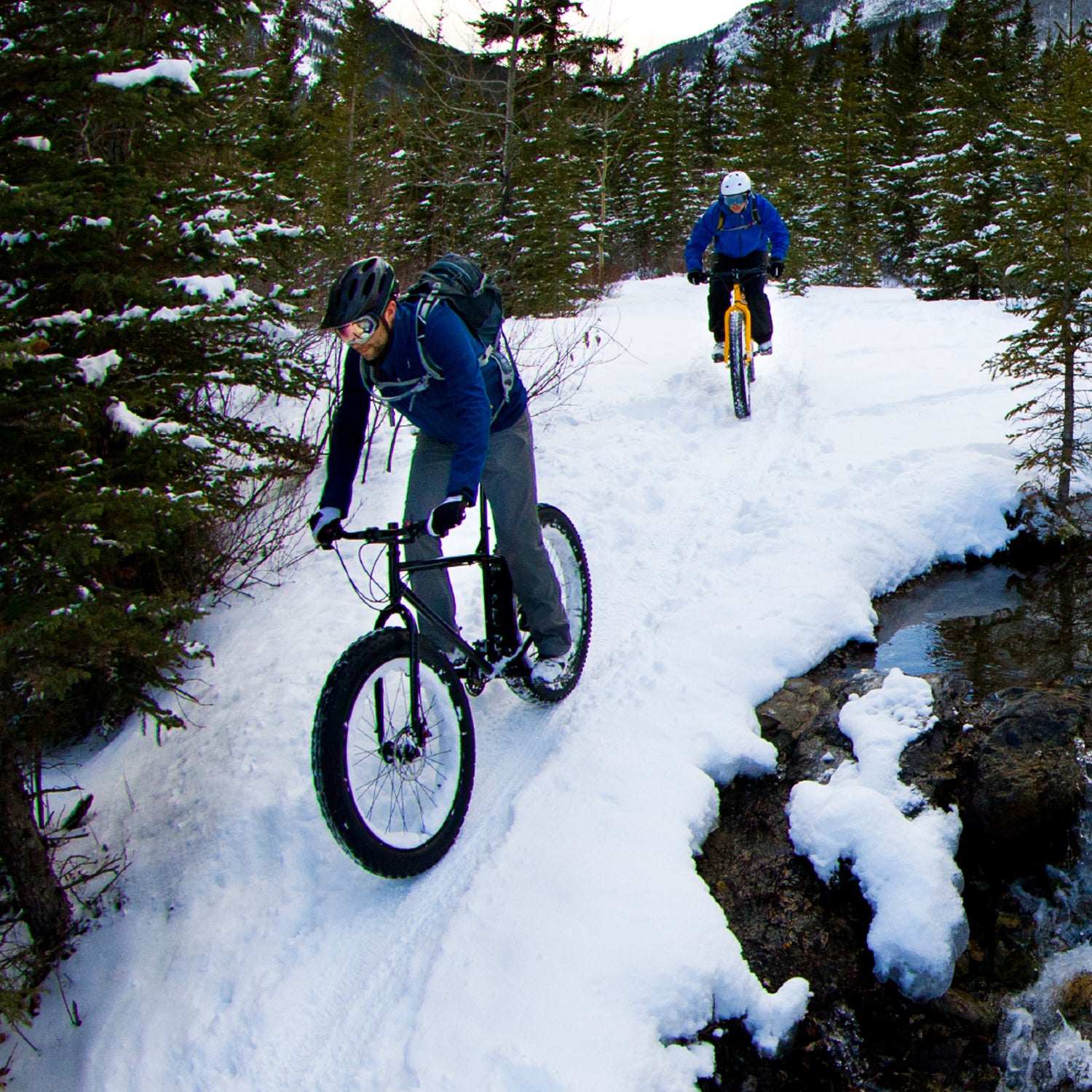Born from man’s desire to conquer snow and sand on two wheels, fat bikes are the go-anywhere toys of cycling. “It’s like having your first big wheel as a kid,” says Minneapolis-based pro cyclist . “It’s hard not to ride a fat bike and not smile at the same time.”
That includes during the winter, when fat bikes open a new world of trails to cycling, including those traditionally used for snowmobiling and cross-country skiing. Those trails are where you’ll find most of the events in the burgeoning fat bike racing scene, which race director, Scott Chambers, likens to the MTB scene 20 years ago.
“People are doing it because it’s really fun. It’s not some gear head, hard-core exercise pro rider thing,” Chambers says. “Everyone has a relaxed, fun attitude. Being outside in the winter, you kind of have to have that attitude.”
If you can ride a bike, you can race a fat bike. Below, Chambers and reigning GLFB Series queen Morgan deliver the inside scoop on all things winter fat bike racing to help you get your four-inch tires wet this year. No excuses.
Pick Your Race
Now in its fourth year, Chambers’ series boasts in the Midwest, ending with the biggest fat bike race in the country: Wisconsin’s , which hosts more than 1,000 riders across 20K and 47K courses. This year’s event is on March 5 and doesn’t require qualification.
“You don’t have to have a lot of technical mountain biking experience,” to do the Birkie, Morgan says, making it a great race for first time off-roaders. Other beginner friendly races in the GLFB Series: Cuyuna Whiteout, The Solstice Chase, and Fat Chance. Expect mostly wide-open groomed trails at those events.
Looking for something tougher? Farmers Fatbike, the Frozen 40, and Polar Roll boast longer courses with more or almost all single track.
Each event is between 1.5 to three hours long. Pick one, or complete at least three races to compete for .
Train
If you’re in decent shape, you can do a fat bike race. Nobody cares if you’re sucking wind. “Just get in the back and have fun,” Chambers says. That’s how fat bikers roll.
That said, it’d help if you fat biked before your race, even if you’ve been doing training rides to stay in killer cycling shape. “Get a friend or find a group of people to ride with because often times when it gets really cold out, it’s easy to say, ‘I’m gonna stay on my couch instead,’” Morgan says. “With an organized ride on the calendar, you’re more likely to commit to it. It’s also more fun.”
Gear Up
It might be possible to rent a fat bike near your race, but any true gear junkie will use a competition as an excuse to go shopping. Like with all bikes, there’s a wide range in prices and frame materials. “Look for a bike in a price point you’re comfortable with,” Morgan says. “You can always sell it on to the next person that’s getting into fat biking if you want to upgrade.” Check out our favorite fat bikes from Fatback and Salsa here.
As for clothes, “gear picks are really about knowing your body,” Morgan says. “Keep a note pad of what gear you wore at what temperatures when you felt like you really nailed it.”
The essentials: gloves and boots. “You need to be mostly concerned about your hands and feet,” Morgan says. “Those are the first things to make you cold and want to go back inside.” So focus on a nice pair of winter gloves with removable liners (that’ll help them dry faster post-race), like these lobsters from series sponsor 45NRTH.
As for boots, “you can start fat biking with a nice pair of winter boots—they don’t need to be cycling shoes,” Chambers says. “Just use a flat pedal.” If you do want to invest in winter cycling shoes, Chambers recommends .��
You’ll also need a helmet. “Snowboard helmets work,” Chambers says. “Or use a merino wool cap with a regular mountain bike helmet.”
Expect to warm up more than you might cross-country skiing, Morgan says. A pair of thermal tights on the bottom should do it. On top, Morgan likes a wool base layer—“Chose wool over cotton or synthetics,” she says, “It keeps you warmer when wet.”—and a midweight jacket. We love Sugoi’s RSX NeoShell. Check out our other cold weather cycling picks here.
Finally, if the course doesn’t loop you through a pit area, you’ll want a hydration pack under your jacket. An insulated hose is nice, but you can always run the hose down your sleeve to keep it warm, Chambers says. If you do go through a pit area, “throw some hand warmers in a cooler to keep your liquids from freezing,” Morgan says.
And don’t forget warm clothes for post-race festivities. “You’d think when it’s zero degrees people would go race then run to their car, but that’s really not the case,” Morgan says. “You go back out there and sit around a fire and talk about the race and the crashes—the crashes are often times more comical than dangerous.”
On PSI
Fat bikes roll at super low PSI to keep traction in sloppy conditions like mud, slush, and fresh powder. “Some people ride as low as four,” Morgan says. “The sweet spot is probably between four and 8.5 depending on the conditions.” Well-groomed trails call for higher PSI. Freshies call for lower PSI. “And by the time you finish, you could be in totally different conditions,” Morgan says. If you’re not sure what to run, overload a little. It’s not weird to see people pull over and let air out of their tires on course, Morgan says.
On Pacing
Expect a fat bike race or ride in good conditions to take you about 1.5 times longer than mountain biking, Morgan says, and about five miles per hour slower than on the road. But it could take longer, depending on the conditions. “If there’s a lot of snowfall, you might do hike-a-bike,” Morgan says.


